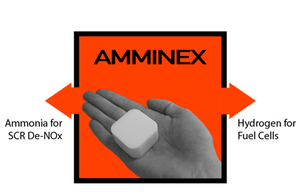Following is the essay you can designate as Volume 10, Number 16 of
This Week’s Clue, based on the e-mail newsletter I have produced since
March, 1997. It would be the issue of April 16. Enjoy.
The key to the future of mankind is chemistry, materials science.
I became a born-again advocate for chemistry from selfish motives, as my alma mater, Rice University, became a leader in nano-technology over the last several years. But it turns out that The War Against Oil depends heavily on materials science if we’re to succeed in our ultimate goal, which is replacing hydrocarbons with hydrogen.
For all their faults, and all their pollution, hydrocarbons have a natural advantage over hydrogen for energy. They’re fairly stable. Oil sits in the ground until it’s pumped out, and simple storage tanks can hold it until it’s needed. The technology needed to crack this store of energy into its components doesn’t use much of the resource. We know how to transport the resulting chemicals to where they’re needed. Everything works.
This isn’t true yet for hydrogen. It’s naturally unstable, as fans of the Hindenberg Disaster are well-aware. Holding it, squeezing it down so you have enough of it for use, and moving it are all big challenges.
We have learned a lot in building our present hydrogen
infrastructure – it’s estimated 2% of the world’s energy right now is
being used to produce industrial hydrogen. But
the cost of storing and transporting hydrogen must come down for the
hydrogen economy to work.
Right now, it can cost over $250/kilogram to store hydrogen gas,
according to a 2003 report which suggested a method for cutting that
cost by 70%. Compressing
or liquefying hydrogen so that it can give you adequate range in a car
engine is a major technological challenge.
The good news is that the costs of delivering hydrogen go down, on a
per-unit basis, as demand goes up. Pipelines cost less than tanker
trucks, tanker trucks less than trucks filled with compressed gas
cylinders.
Then there is materials science.
In 2005 Danish scientists produced a hydrogen tablet
based on
Magnesium Chloride (MgCl2) that can be transported safely, using simple
ammonia and salt. Ammonia, which contains the hydrogen, is released
with a catalyst which decomposes the free hydrogen. The tablet can
then be re-charged with ammonia. The technology is now being
commercialized through a company called Amminex.
I don’t know how well Amminex’ technology will work in the mass
quantities needed to replace hydrocarbons with hydrogen. But I do know
that the route toward solving that problem is the one used here,
materials science.
We have the same problem with electricity. Did you know electric utilities lose
over half the power they generate transporting it to you? There are
technologies available that cut this loss in half, but they can cost as
much as $1 million/mile. Most power plants are hundreds of miles from
the communities they serve.
A 2003 study in Florida found that utilities are dramatically
under-investing in their transmission systems and can reduce both
losses from leakage and community opposition by switching to
superconductors.
The U.S. Department of Energy programs to deal with problems in the
grid are called GridWorks and GridWise.
The amount of money being spent on these efforts is pitiful. Worse,
it’s being wasted, essentially used as a subsidy and an excuse for
inaction by the existing electrical utilities.
Much more needs to be done. Carbon nanotubes (Buckytubes, as we Rice People call them) act as a room
temperature superconductor, which can reduce losses of electricity
during transmission to near zero. But building transmission lines with
them, or even producing them in production-grade quantities, remains an
immense challenge. Again, materials science.
Entrepreneurial competition is also needed, of course. Right now the
priority for putting breakthroughs into practice is governed by
electric utilities who have little incentive to make change happen. All
these see are costs. They demand that costs be covered before
investments are made. This despite the fact that the investments would
more than pay for themselves in increased yields of power to consumers.
That’s why we need to put all this on a war footing.
One of the strangest old movies I’ve ever seen was called Pittsburgh. It
starred John Wayne and Randolph Scott as steel executives, with Marlene
Dietrich as the woman in the middle. (Like I said, strange.) But it was
also, at heart, a propaganda movie, and the last scene showed all three
with researcher Frank Craven, who went on-and-on about the use of coal
tar in things like tires and sulfa drugs. Hokey as hell, but that’s
what a real war footing is like.
The War Against Oil cannot be won unless material science
improvements are made an absolute priority, and unless putting such
improvements into practice is made an absolute priority. We have the
technology, or we can get it. What we lack right now is the will.













Developing Nanotubes into wire might benefit from being combined with our polymer Ultraconductors(tm). See the website: http://www.ultraconductors.com
These ambient temperature materials are the equivalent of a room temperature superconductor. They have been the subject of four completed SBIR contracts with the DOD, one of which was a Phase II with the USAF. This work has been done by Room Temperature Superconductors Inc., a subsidiary of Magnetic Power Inc. That website is: magneticpowerinc.com A recent breakthrough is the first item on the site. This work suggests low cost electric power generation can rapidly supersede the fossil fuels as well as nuclear power. With sufficient support all of this development work could be greatly accelerated. We would be happy to have Rice involved with our Ultraconductors.
Developing Nanotubes into wire might benefit from being combined with our polymer Ultraconductors(tm). See the website: http://www.ultraconductors.com
These ambient temperature materials are the equivalent of a room temperature superconductor. They have been the subject of four completed SBIR contracts with the DOD, one of which was a Phase II with the USAF. This work has been done by Room Temperature Superconductors Inc., a subsidiary of Magnetic Power Inc. That website is: magneticpowerinc.com A recent breakthrough is the first item on the site. This work suggests low cost electric power generation can rapidly supersede the fossil fuels as well as nuclear power. With sufficient support all of this development work could be greatly accelerated. We would be happy to have Rice involved with our Ultraconductors.